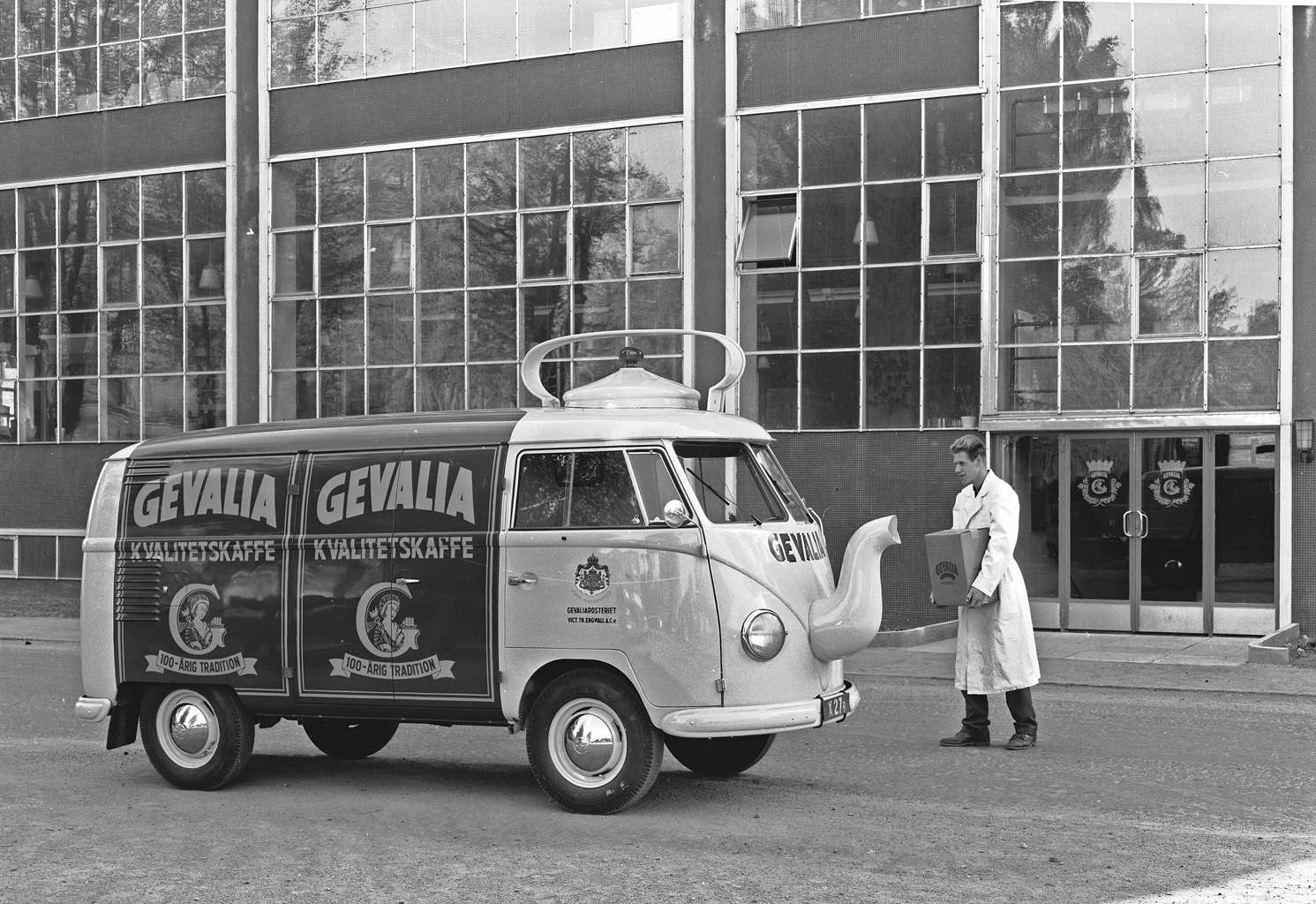【2018 Archives】
Java Jive
Our Daily Correspondent

A coffeepot truck from 1956. Photo via Retronaut
There are too many coffee clichés: nineties Seattle yuppies, current obsessives in Portland and Brooklyn, the enormous and always hilarious line of tchotchkes that emphasize the importance of caffeine to functioning and the inadvisability of approaching the addict pre-coffee. And that Friendspop-up! Oh god, the Friendspop-up. It makes one squirm with vicarious humiliation. It is impossible to mention coffee in any context without falling into some hoary cliché trap, which I imagine being like one of those pits cleverly disguised with leaves. But there’s a funny paradox at work: however much we take it for granted, coffee has become a sort of identity. In a time when the real thing is scarce, coffee is sold to us as craftsmanship, as connoisseurship, as signifier—for ideas of glamor that very few of us can actually afford.
It was not always so. Joseph Smith reported that hot drinks are not for the body or belly; Bach wrote the “Coffee Cantata”; and Balzac may or may not have died of coffee poisoning:
I have discovered a horrible, rather brutal method that I recommend only to men of excessive vigor, men with thick black hair and skin covered with liver spots, men with big square hands and legs shaped like bowling pins. It is a question of using finely pulverized, dense coffee, cold and anhydrous, consumed on an empty stomach. This coffee falls into your stomach, a sack whose velvety interior is lined with tapestries of suckers and papillae. The coffee finds nothing else in the sack, and so it attacks these delicate and voluptuous linings; it acts like a food and demands digestive juices; it wrings and twists the stomach for these juices, appealing as a pythoness appeals to her god; it brutalizes these beautiful stomach linings as a wagon master abuses ponies; the plexus becomes inflamed; sparks shoot all the way up to the brain. From that moment on, everything becomes agitated. Ideas quick-march into motion like battalions of a grand army to its legendary fighting ground, and the battle rages. Memories charge in, bright flags on high; the cavalry of metaphor deploys with a magnificent gallop; the artillery of logic rushes up with clattering wagons and cartridges; on imagination’s orders, sharpshooters sight and fire; forms and shapes and characters rear up; the paper is spread with ink—for the nightly labor begins and ends with torrents of this black water, as a battle opens and concludes with black powder.
I recommended this way of drinking coffee to a friend of mine, who absolutely wanted to finish a job promised for the next day: he thought he’d been poisoned and took to his bed, which he guarded like a married man. He was tall, blond, slender and had thinning hair; he apparently had a stomach of papier-mâché. There has been, on my part, a failure of observation.
Those of you who celebrate obscure and dubious “holidays” already know that September 29 is International Coffee Day. You—and gleeful penny-pinchers around the globe—are probably aware that many places will give you a free cup of joe in commemoration. The promotion was first launched by the All Japan Coffee Association in 1983; in 2009 the Southern Food and Beverage Museum called a press conference to announce the first New Orleans Coffee Festival, and in so doing made the term “International Coffee Day” official. (No offense intended to the Southern Food and Beverage Museum—I thoroughly enjoyed the sights there, especially the selection of absinthe spoons—but I didn’t know this sort of coinage was so easy.) One suspects the laudable goal of promoting fair-trade and supporting coffee farmers is a more modern one.
If you wish to revisit a time when coffee was both powerful and unburdened by cliché, go down the rabbit hole of giant coffeepots. As this terrific gallery makes clear, you used to be able to pull up to coffeepot-shaped buildings around the country (along with the occasional giant duck or milk bottle); even today, you could make quite a road trip of it. But even better, for my money, is this handsome fleet of coffeepot trucks that brought whimsy and caffeine wherever they went. This sort of literal vernacular design has fallen out of fashion for some reason, but here was lordship; here was dignity. What could rival that? Besides, perhaps, an espresso cart shaped like Balzac.
Search
Categories
Latest Posts
Keeping Education on the Radar
2025-06-25 22:50The Bill O'Reilly/Smash Mouth mashup nobody was asking for
2025-06-25 22:32'The X
2025-06-25 20:40Moving Targets
2025-06-25 20:34Popular Posts
Justin Trudeau and his Socks
2025-06-25 22:37Chris Evans is making his Broadway debut. Thank you, world.
2025-06-25 21:45Chris Evans is making his Broadway debut. Thank you, world.
2025-06-25 21:42Take a peaceful moment to watch this baby hippo shower
2025-06-25 20:27Get Thee to a City of Ladies
2025-06-25 20:26Featured Posts
Twilight of the Racist Uncles
2025-06-25 22:11Google Play update makes it easy to delete unusued Android apps
2025-06-25 21:54A Telling Moment
2025-06-25 20:12Popular Articles
Kanye Unbound
2025-06-25 22:29'Mario Kart 8 Deluxe' reviews are in: Still great, three years later
2025-06-25 21:17Newspaper succinctly trolls Trump's new pick for country ambassador
2025-06-25 21:12Hang-Ups
2025-06-25 20:15Newsletter
Subscribe to our newsletter for the latest updates.
Comments (7113)
Shocking Information Network
Don’t Give Up on Universities
2025-06-25 22:42Exploration Information Network
Dustin from 'Stranger Things' wins Best Actor at Shorty Awards
2025-06-25 22:19Style Information Network
Google Play Music will now be the default on all Samsung devices
2025-06-25 21:46Information Information Network
All the best (and geekiest) signs from Marches for Science around the world
2025-06-25 21:08Style Information Network
Epic Systems v. The Work Force
2025-06-25 20:40